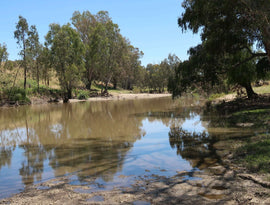A property dubbed Mooney Valley, southeast of Wagga Wagga in New South Wales, has been used as farmland for decades. Proud of their work from generation to generation, the family’s dream was to balance agriculture with environmental benefits. This lead to a partnership between Greenfleet and landholder Wendy Smith. “In 2004 and 2006, Greenfleet planted 13,000 native seedlings across 17.5 ha of the property, to turn unproductive areas of the farm into biodiverse islands for native plants and animals to flourish, to protect sheep from the elements and to create a barrier from strong winds which blow away the topsoil from cropping paddocks,” explained Greenfleet Forester Eoghan O’Connor. At the time, we caught up with Wendy, to get an update on the growing forest. Wendy explained that the initial vision was to stop erosion, reduce soil salinity and revegetate the land back to its original unique beauty. “We had seeded three areas ourselves across the property; unfortunately, this happened to be at the same time as two of the driest years in the region,” Wendy explained. “In 2004, Greenfleet contacted us and offered to plant the areas with seedlings and that’s how it started for us. Together with Scouts Australia, they planted 5,000 native trees.”
She added that thanks to a grant from the government, they were able to fence off additional land that Greenfleet were able to revegetate. This meant a further 8,000 trees were added to the site. In early 2006, a bush fire swept through the area affecting a very small plot of the planting, burning some trees and grasslands, but thankfully leaving the buildings on the property intact.
“Many of the young wattles in this area died during the fire, however the eucalypts survived, and with the fertile seed bed left after the blaze, much natural germination occurred from adjacent remnant vegetation. Further rehabilitation works were not necessary on account of this recruitment, displaying the natural process of dry eucalypt forests," said Eoghan. Despite these early challenges, the trees at Mooney Valley are now thriving. On of the things Wendy was most excited about was the return of many native animals, “Bird species, especially rosellas and parrots. We’ve also seen an increase in Kangaroos.” Wendy went on to say that the forest, “makes the countryside more attractive.”
The unique beauty of the Australian environment is iconic around the world. By planting locally native species, Greenfleet is re-building ecosystems and creating biodiverse forests. Forests like the one at Mooney Valley provide vital habitat for animals. “There are benefits to the native animals and bird life. People can see them in their native area rather than in a zoo,” said Wendy. As it grows and flourishes into a biodiverse paradise, the forest at Mooney Valley is also sequestering tonnes of carbon. The forest is estimated to capture 6,725 tonnes of CO2-e by 2034. That’s equivalent to removing 1,528 average medium-sized cars off the road for one year!
Greenfleet’s revegetation work at Moonee Valley is a prime example of how our projects fight climate change while restoring native forests. The carbon footprint of our everyday lives can be mitigated through offset donations to Greenfleet. Thanks to their offset donations, all our supporters are supporting reforestation projects around Australia and New Zealand. For 20 years, Greenfleet has provided the community with the opportunity take practical climate action with genuine environmental benefits. It’s never too late to get started: offset your car, household or flights’ carbon emissions today with Greenfleet and make a real difference to our environment.

Location Size
Planting Dates
Species
- Acacia buxifolia
- Acacia dealbata
- Acacia decora
- Acacia doratoxylon
- Acacia implexa
- Acacia leucoclada
- Allocasuarina luehmanni
- Allocasuarina verticillata
- Callistemon sieberi
- Callitris glaucophylla
- Dodonaea viscosa
- Eucalpytus melliodora
- Eucalpytus polyanthemos
- Eucalyptus albens
- Eucalyptus blakelyi
- Eucalyptus bridgesiana
- Eucalyptus camaldulensis
- Eucalyptus microcarpa
- Eucalyptus sideroxylon




